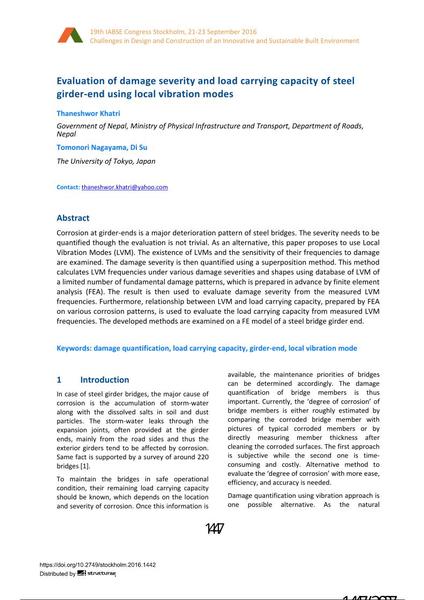Evaluation of damage severity and load carrying capacity of steel girder-end using local vibration modes

|
|
|||||||||||
Détails bibliographiques
| Auteur(s): |
Thaneshwor Khatri
(Government of Nepal, Ministry of Physical Infrastructure and Transport, Department of Roads, Nepal)
Tomonori Nagayama (The University of Tokyo, Japan) Su Di (The University of Tokyo, Japan) |
||||
|---|---|---|---|---|---|
| Médium: | papier de conférence | ||||
| Langue(s): | anglais | ||||
| Conférence: | IABSE Congress: Challenges in Design and Construction of an Innovative and Sustainable Built Environment, Stockholm, Sweden, 21-23 September 2016 | ||||
| Publié dans: | IABSE Congress Stockholm, 2016 | ||||
|
|||||
| Page(s): | 1447-1454 | ||||
| Nombre total de pages (du PDF): | 8 | ||||
| Année: | 2016 | ||||
| DOI: | 10.2749/stockholm.2016.1442 | ||||
| Abstrait: |
Corrosion at girder-ends is a major deterioration pattern of steel bridges. The severity needs to be quantified though the evaluation is not trivial. As an alternative, this paper proposes to use Local Vibration Modes (LVM). The existence of LVMs and the sensitivity of their frequencies to damage are examined. The damage severity is then quantified using a superposition method. This method calculates LVM frequencies under various damage severities and shapes using database of LVM of a limited number of fundamental damage patterns, which is prepared in advance by finite element analysis (FEA). The result is then used to evaluate damage severity from the measured LVM frequencies. Furthermore, relationship between LVM and load carrying capacity, prepared by FEA on various corrosion patterns, is used to evaluate the load carrying capacity from measured LVM frequencies. The developed methods are examined on a FE model of a steel bridge girder end. |
||||

